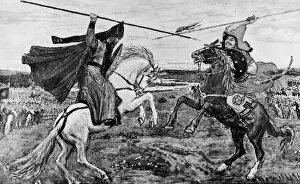Mongols Collection (page 3)
The Mongols, known for their fierce horsemanship and military prowess, were a formidable force in history
All Professionally Made to Order for Quick Shipping
The Mongols, known for their fierce horsemanship and military prowess, were a formidable force in history. Mongol horsemen rode with unmatched skill and precision, demonstrating their mastery of the art of war on horseback. Their soldiers showcased their horsemanship through daring maneuvers and lightning-fast attacks. Amidst the vast steppes, a Siberian Tartar woman found love with a Russian Mongol couple, bridging cultures and forming an unbreakable bond. The nomadic lifestyle of the Mongols meant constantly moving camp, adapting to new surroundings while maintaining their strong sense of unity. Genghis Khan, the visionary emperor who founded the Mongol Empire in 1162-1227 CE, left an indelible mark on history. His leadership skills and strategic genius propelled his empire to great heights as they conquered vast territories across Asia. In Persia's Soltaniyeh province lies Pasargadae-00001; it stands as a testament to the influence of the mighty Mongols in this region. This ancient city witnessed both triumphs and tribulations under their rule. A captivating photograph by Sergey Mikhaylovich Prokudin-Gorsky depicts Mohammed Alim Khan, the last Emir of Bukhara in 1911. It serves as a poignant reminder that even centuries later, traces of Mongolia's impact can still be seen. Rashid al-Din's Compendium of Chronicles offers valuable insights into Persian history during this era. It sheds light on how Persia was influenced by its interactions with these powerful conquerors from afar. Persia's Soltaniyeh province holds many secrets waiting to be discovered - remnants from when it fell under Mongol control centuries ago. These ruins serve as silent witnesses to an era filled with conquests and cultural exchanges between East and West. The legacy left behind by the mongols is one that cannot be ignored.























